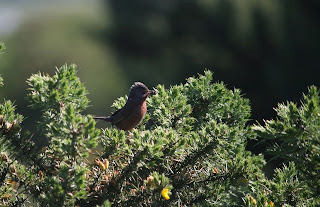A couple of weeks ago, I was fortunate enough to visit the Orkney
islands off the North coast of Scotland. A patchwork of ancient sites, standing
stones, wild seas and cattle farms, of jewelled wild flower meadows and
moorland in bloom, where blue butterflies and bumblebees live only in sheltered
hollows, where Neolithic villages and places of worship stand testimony to the
ingenuity of our ancient ancestors, Orkney is a remote, and fascinating
place.
One afternoon, I drove in the sunshine to the RSPB’s Cottascarth viewpoint, on the moors not far from Finstown. While on the road I encountered, and photographed, very badly as it turned out, a beautiful Oystercatcher chick, in the company of a parent. The chick still had some down, though its adult feathers had begun to show, and it was nearly ready to take to the skies. Oystercatchers breed in substantial numbers in Orkney’s farmland. I took the narrow, twisting track through farm buildings to the viewpoint, where, green-roofed and windowed, but still clearly crafted from abandoned croft buildings, stood the RSPB hide. Optimistic, I waited and enjoyed the surroundings, hoping to catch a glimpse of a Hen Harrier. The occasional call of a Curlew echoed from the hills, or an Oystercatcher alarm call rose from the farmland and the flock of linnet which alighted briefly on the roof of the hide. A few sheep grazed. After about an hour the Harrier appeared, a male, a smart, grey bird, with black, fingered wingtips, a grey ghost over the moorland, hanging on wings with the characteristic dihedral. Hen Harriers hunt in part by hearing, and by sight, and prey on voles, as well as young ground nesting birds. The male made a couple of passes, his attention fully focussed on the ground below, looking for voles or any unfortunate small birds, before disappearing over the ridge into the valley behind. I waited another few minutes, hoping this magnificent bird would reappear, but he did not, and I began to make my way back to the small car park ready to head back to my camp site.
As made my way back to the car I saw the male glide over the place I had just been standing. With some disappointment at missing out on this close view, enjoyed his majestic hunting through binoculars. I headed back down to the coast roads. Driving slowly on empty roads with my eyes open for birds, I became aware of the mother Oystercatcher I had encountered earlier. She was loudly and aggressively mobbing something in the field, down beyond a low brow hidden from sight. She’d break away bto chase off a passing Hooded Crow, though these birds did not seem to go far, then returning to her target on the ground, strafing with her sonic weapon, her passes low and frequent, her calls rhythmic but high and frantic. I slowed down, wondering what could possibly have enraged her like this. Then, just 15 metres or so from my window, I saw what had happened. On top of a sad, white lump with feathers, feet extended toward the sky, stood a female Hen Harrier. Her golden yellow eyes, set in a subtle facial disc recalling an owl, glanced to me, before, unconcerned by me or the distraught mobbing of the adult Oystercatcher, returning to plucking her prize.
My heart in my mouth, I silently reached for my camera and grabbed a few photos through the passenger window. I watched the bird, predator, as she continued to remove the downy feathers from her prey, scattering them to the wind like dandelion seeds, calmly, yet so alert, eyes scanning in all directions. The adult did not relent from calling.
Suddenly the bird was on the move, a grey shape emerging from the bushes. A farm cat burst out from cover toward the bird of prey. With her wings spread, her imposing size was apparent. She struggled into the air with her prize, but it was a little too heavy, and she dropped it. The dead Oystercatcher chick flopped limp to the ground. She swooped in on it again, and stood on it, bearing a steely look, extending her wings to protect her prize. But the farm cat was determined. The next spring it made, the bird was off and flying, back toward the hills, and the Oystercatcher chick was clasped firmly in the jaws of the tabby. It sloped off, toward some farm buildings to enjoy its prize. I considered some attempt to scare the cat off, in the hope the Harrier would return, but I figured even semi-feral mammals must eat, and a cat brave enough to take on an adult Hen Harrier, talons and all, must be very hungry indeed.
My heart still in my mouth, I sat for a while, as a band of thick, grey cloud rolled in over the sea, and the cool rain began to fall. A double rainbow arced from the horizon. A confused and angry adult Oystercatcher stood on a fence post, yelling at the wind.
















